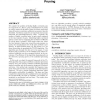Free Online Productivity Tools
i2Speak
i2Symbol
i2OCR
iTex2Img
iWeb2Print
iWeb2Shot
i2Type
iPdf2Split
iPdf2Merge
i2Bopomofo
i2Arabic
i2Style
i2Image
i2PDF
iLatex2Rtf
Sci2ools
109
click to vote
CIKM
2006
Springer
2006
Springer
Finding highly correlated pairs efficiently with powerful pruning
We consider the problem of finding highly correlated pairs in a large data set. That is, given a threshold not too small, we wish to report all the pairs of items (or binary attributes) whose (Pearson) correlation coefficients are greater than the threshold. Correlation analysis is an important step in many statistical and knowledge-discovery tasks. Normally, the number of highly correlated pairs is quite small compared to the total number of pairs. Identifying highly correlated pairs in a naive way by computing the correlation coefficients for all the pairs is wasteful. With massive data sets, where the total number of pairs may exceed the main-memory capacity, the computational cost of the naive method is prohibitive. In their KDD'04 paper [15], Hui Xiong et al. address this problem by proposing the TAPER algorithm. The algorithm goes through the data set in two passes. It uses the first pass to generate a set of candidate pairs whose correlation coefficients are then computed ...
Related Content
| Added | 20 Aug 2010 |
| Updated | 20 Aug 2010 |
| Type | Conference |
| Year | 2006 |
| Where | CIKM |
| Authors | Jian Zhang, Joan Feigenbaum |
Comments (0)

